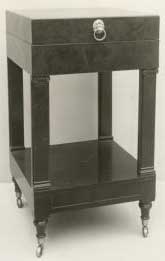Federal Style Furniture
American Revolution fought and won,
The style of Chippendale is done.
History
In 1783, the Treaty of Paris, ending the American Revolution, recognized the independence of the United States of America and a new nation was born. The war-ravaged country was given the chance to begin to build its own government, constitution and traditions and the so-called Federal period began, roughly running from 1780 to 1820.

The sofa used by George Washington when living in Philadelphia as President of the United States.
Federal Style : Origins
This era, rich in history and heritage, gave rise to the unique American furniture known as Federal style furniture, which replaced the older American Chippendale style. Despite the new country's recently won independence, the English influences of Hepplewhite and Sheraton, were paramount in the early Federal era.

The table on which the Treaty of Ghent, 1814, was signed.
Early Styles
Early American federal furniture of this era did full justice to the elegant high society of the young nation. Ladies in silks and muslins sipped tea in the drawing room; gentlemen in tight-fitting coats and wigs discussed the stirring events of the new Federation in well-appointed libraries. Law makers and entrepreneurs, rich traders and their fashion-conscious wives, all with money to spend and a position in society to maintain, created beautiful homes and interiors in a style which is still prized by antique lovers today. In the historic districts from which the capital was born, such as Georgetown, Alexandria, and Rosslyn, Virginia, Federal furniture and architecture is preserved in an abundance of museums and show houses.
Cherry and Walnut
Dark woods were popular at this time. In Europe, mahogany was the most popular, but many American furniture manufacturers used cherry, which is just as beautiful. Walnut stained to a deep red with potassium chloride was also used by some cabinetmakers as a slightly less expensive option. Intricate workmanship is typical of Federal furniture, and many pieces featured inlays of different types of wood, or of wood scorched to give areas of light and dark contrasts. Painted or string inlays were also used for decoration. Stars and eagles, the symbols of the new nation, are often seen in American furniture instead of the classical emblems of European furniture of this era. This is especially true of the later part of this period.

Antique Federal Highboy by Samuel McIntire.
Federal Era Designers
One of the most famous designers of Federal era furniture was Duncan Phyfe, who individualized the Sheraton style with innovations of his own. Working mainly in mahogany, he was best known for his chairs that featured concave backs, concave legs and classical motifs. Charles Honore Lannuier, another popular designer of the day, followed the French Directoire style, and made much use of brass and gilded ornamentation. Other designers of American federal period furniture included Michael Allison, John Shaw, John Dolan, Samuel McIntire, and George Woodruff.

Duncan Phyfe Washstand.
Elegant and Graceful
The Federal era in American furniture produced some of the most elegant, graceful and truly beautiful antique furniture in existence. During the years when George Washington crafted a nation, contemporary cabinetmakers crafted a tradition in fine furniture that endures today. Antiques of the "American Empire" period are of enormous value today.
